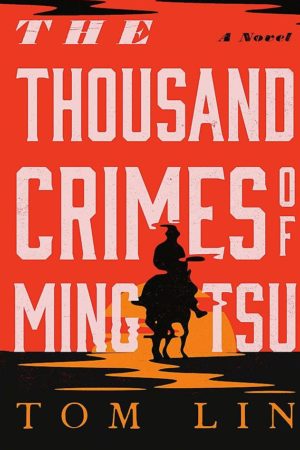The Thousand Crimes of Ming Tsu
by Tom Lin
reviewed by Hardeep Sidhu
On May 10, 1869, a final spike joined the two halves of the first transcontinental railroad in the Utah Territory. Chinese labor had made up 90% of the workforce that dynamited the earth and laid the rails. But, writes historian Erika Lee, “the Chinese workers who had made it all possible were nowhere to be found in official photographs commemorating the occasion.” Chinese labor—even the simple fact of Chinese presence—was written out of the story.
Tom Lin has written a fierce corrective to this long tradition of erasure in his debut novel, The Thousand Crimes of Ming Tsu. “They say there’s riches like you wouldn’t believe in them rails,” says Ming, a Chinese American gunslinger in the old West. “All kinda money in the buildin and the gradin and the blastin and the layin. Money in the land them rails run over and the land right next to that too. About the only thing there ain’t money in is them Chinese’s pockets.”
Lin’s novel is both an homage and an update to classic Westerns. Ming Tsu is an assassin out for revenge. The orphaned son of Chinese immigrants, Ming trains under a white outlaw to be a criminal enforcer. When Ming’s clandestine marriage to a white woman, Ada, incurs the wrath of her powerful father, Ming is beaten, arrested, and condemned to hard labor building the railroad. Now, after ten years of toil, Ming escapes and draws up a list of the men who have wronged him. In a grisly bit of pulp poetry, Ming wields a sharpened six-inch rail spike to dispatch his enemies. He lights out—westward, of course—to right wrongs and find his lost love.
Lin produces gripping scenes: the outlaw Ming mocks a sheriff’s pretension to justice; an innocent Chinese man suffers in Ming’s place; a rockslide buries railroad laborers alive. In a standout sequence, Ming stumbles across the frozen body of a Chinese laborer in the mountains. Ming solemnly reconstitutes a “false memory” of the stranger’s demise and wonders at length about the particulars of his life. “It is through labor that men remember anything at all,” thinks Ming, in words that speak for Lin’s novel, too. Ming builds a humble monument to honor the stranger’s life and bear witness to his death.
Despite the promise of these scenes, the novel is frustratingly uneven and strangely paced overall. Short, punchy episodes offer new renditions of familiar scenes like labor disputes, stagecoach chases, and saloon shootouts. Cormac McCarthy is an obvious influence: Lin renders settings vividly and describes action—especially violence—with a craftsperson’s precision. But Lin has a bad habit of resolving each chapter’s conflict too fast: our outlaw rides into town, gets his guy, and makes tracks. The result is an episodic structure with no cliffhangers—a plot that doesn’t develop so much as it dutifully proceeds.
The novel takes a magical-realist turn when Ming travels with a carnivalesque “miracle” show made up of orphans and outcasts. We meet a deaf boy who throws his voice, a fireproof woman, a shapeshifting Pacific Islander, and a Navajo man who can erase memories, among others. Through this motley cast, Lin spins out big themes: the relation of outsiders to society, the fleetingness of human life, the contest of memory and imagination. The result, however, is a set of secondary characters that function more like props than people. Lin gives women characters conspicuously short shrift: Ming “looked at [Ada] and though he knew he loved her he could not remember why.” Neither can we.
The Thousand Crimes of Ming Tsu is best—most fun, most urgent—when tightly focused on Ming himself, fully indulging Lin’s thought experiment: What would a Chinese American hero from the era of Manifest Destiny be like? How would adopting his perspective scramble the conventions of the Western? And how would staking a claim to the Western redraw the contours of Asian American literature and the US immigrant narrative? When Lin gives himself free rein here, he opens up new literary territory. “[W]here memory fail[s],” he writes, “imagination [takes] fire.”
Published on September 23, 2021

